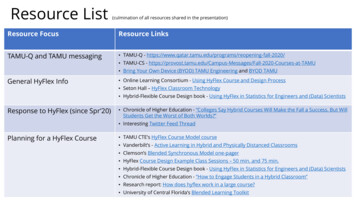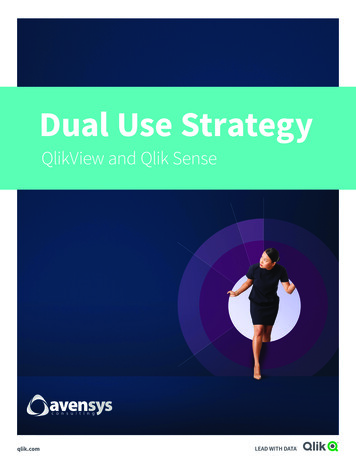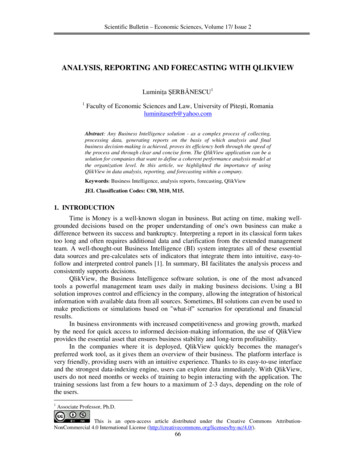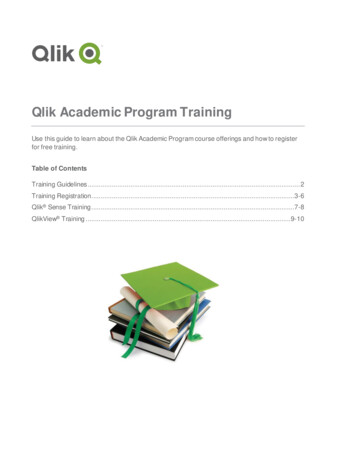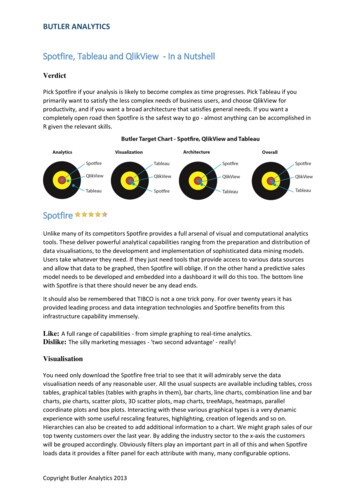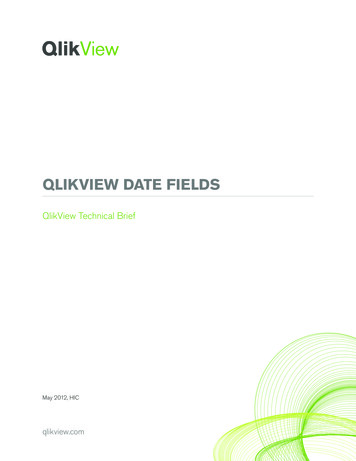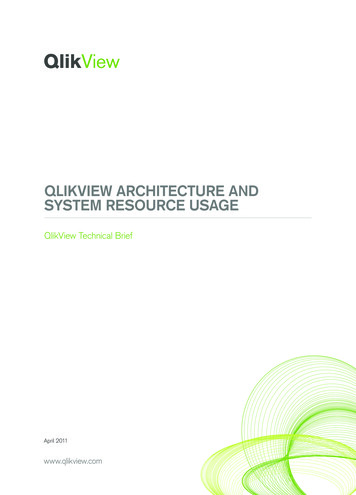
Transcription
QLIKVIEW ARCHITECTURE ANDSYSTEM RESOURCE USAGEQlikView Technical BriefApril 2011www.qlikview.com
IntroductionThis technical brief covers an overview of the QlikView product components and architectureand provides a technical discussion on how QlikView utilizes system resources such as CPUand RAM.The first section, QlikView Architecture, provides an understanding of the product componentsand how they fit together to constitute a typical deployment scenario.The second section, QlikView System Resource Usage describes how QlikView utilizes andinteracts with server hardware resources, explains QlikView’s approach to data compressionand discusses how the different QlikView components use different system resources.This technical brief is a companion piece to the QlikView Scalability Overview TechnologyWhite Paper as it provides a fundamental grounding from which a better understanding of howQlikView scales can be gathered. It is recommended that the reader download and read theScalability Overview Technology White Paper after reading this technical brief. Page 2
QlikView ArchitectureWhen approaching a decision to implement and deploy QlikView, it’s important to firstunderstand the roles of the various products that comprise a QlikView deployment.Figure 1 depicts a simplified view of a standard QlikView deployment containing the location ofthe various QlikView products as well as both data and application locations.User DocumentsQVP or HTTPSQlik View qvw and.meta file structureQlikView ServerFront EndClientsQVPBack EndSource DocumentsQlikViewDelevoperQlik View qvw andqvd file structureQlikView PublisherInfrastructure resourceNAS/SAN StorageSMTP serviceDirectory Catalog(Active DirectoryE- Directory)DataWarehouseData SourcesFigure 1: Architecture Overview.QlikView deployments have three main infrastructure components: QlikView Developer,QlikView Server (QVS) and QlikView Publisher.QlikView Developer is a Windows-based desktop tool that is used by designers anddevelopers to create 1) a data extract and transformation model and 2) to create thegraphical user interface (or presentation layer).QlikView Server (QVS) handles the communication between clients and the QlikViewapplications. It loads QlikView applications into memory and calculates and presents userselections in real time.QlikView Publisher loads data from different data sources (oledb/odbc, xml, xls), reducesthe QlikView application and distributes to a QVS.Because QlikView Server and Publisher have different roles and handle CPU and memorydifferently it’s considered a best practice to separate these two components on different servers. Page 3
Back End (Including Infrastructure Resources):This is where QlikView source documents, created using the QlikView Developer, reside.These source files contain either a) scripts within QVW files to extract data from the variousdata sources (e.g. data warehouses, Excel files, SAP, Salesforce.com) or b) the actual binarydata extracts themselves within QVD files. The main QlikView product component that resideson the Back End is the QlikView Publisher: the Publisher is responsible for data loads anddistribution. Within the Back End, the Windows file system is always in charge of authorization(i.e. QlikView is not responsible for access privileges).The Back End depicted in figure 1 is suitable for both development, testing anddeployment environments.Front End:The Front End is where end users interact with the documents and data that they areauthorized to see via the QlikView Server. It contains the QlikView user documents that havebeen created via the QlikView Publisher on the back end. The file types seen on the FrontEnd are QVW, .meta and .shared documents. All communication between the client andserver occurs here and is handled either via HTTPS (in the case of the AJAX client) or via theQlikView proprietary QVP protocol (in the case of the plugin or Windows client). Within theFront End, the QVS is responsible for client security.Associative In-Memory Technology:QlikView uses an associative in-memory technology to allow users to analyze and process datavery quickly. Unique entries are only stored once in-memory: everything else are pointers to theparent data. That’s why QlikView is faster and stores more data in memory than traditional cubes.Memory and CPU sizing is very important for QlikView, end user experience is directly connectedto the hardware QlikView is running on. The main performance factors are data model complexity,amount of unique data, UI design and concurrent users. Page 4
QlikView System Resource Usage:At this point it’s important to describe at a fundamental level how QlikView’s core technology usessystem resources like RAM, CPU capacity and so on.Let’s take a look at how both the QlikView Server and the QlikView Publisher both typically usedifferent system resources:QLIKVIEW SERVER (QVS)CPUQlikView Server is multi threaded and optimized to take advantage of multiple processor cores.All available cores will be used almost linearly when calculating the QlikView objects (tables andgraphs). The QVS makes a short burst of intense CPU usage when doing any calculations andthese are done in real time.CPU Usage HistoryFigure 2: Typical CPU usage for the calculation of a QlikView Object.QlikView Server has a central cache function. This means that QlikView object calculations onlyneed to be done once. Obviously the benefits are better user experience (i.e. faster responsetimes) and lower CPU utilization.HOW DOES QLIKVIEW USE THE PROCESSOR:QlikView leverages the processor to dynamically create aggregations as needed in real timeresulting in a fast, flexible, and intuitive experience for end users.It is important to realize that the data stored in RAM is the unaggregated granular data. Typicallyno preaggregation is preformed in the data reloading/script execution process. When the userinterface requires aggregates (e.g. to show a chart object or to recalculate after a selection ismade) the aggregation is done in real time. This requires processing power from the CPU. Page 5
IMPACT OF NOT ENOUGH PROCESSING POWER:The primary symptom of a lack of CPU processing power is to wait for charts to recalculate.Under normal conditions chart recalculation takes place almost instantaneously. However withtruly massive datasets and without a corresponding increase in processing power, the time tocalculate charts can become greater than 1 sec.A major function of the QVS isto load QlikView applications(.qvw’s) into memory. Thememory size needed depends on: If at any time QlikView performance is judged to slow down it is addressed by addingprocessing power. Quite simply QlikView scales almost perfectly with the addition of morecores and more CPU’s. If a given query takes 6 seconds to run against a single core CPU (of agiven speed), then the same query will take 3 seconds to run against a dual core CPU (of the The application size in memory,same speed). It will take 1.5 seconds against a quad core CPU and 0.75 seconds againstit is often bigger than the actualtwo quad core CPUs, etc. One must take into account some additional processing overheadapplication size.when scaling with cores, however the effects on proportional linear scaling are minimal. How the application isConversely, if additional users are making the same query then the response time will scaledesigned. A poorly designedlinearly according to the number of simultaneous users making the request and the amount ofapplication could utilizeprocessing power available to the application. QlikView application size (inuncompressed format).unnecessary memory amounts(This topic is covered in theAs an increasing number of users make requests to the application with a finite number ofQlikView Scalability Overviewcores or CPU’s, performance degradation naturally occurs. This is most commonly offset byWhite Paper). How the data model isdesigned (e.g. avoiding usingsynthetic keys can reduce thememory footprint needed). Number of users accessingapplications on the server(This topic is covered in theQlikView Scalability OverviewWhite Paper).scaling horizontally using a clustering and load balancing technique.MEMORY:Main memory RAM is the primary storage location for all data to be analyzed by QlikView.QlikView uses RAM to store the unaggregated dataset to be analyzed as well as theaggregated data and session state for each user viewing a QlikView document.QlikView is a snapshot based technology. The snapshot is refreshed through a process known asreloading a QlikView document. When a QlikView document is reloaded QlikView will establish A useful rule of thumb is to add connectivity to the datasource (or datasources) to be analyzed and extract all the unaggregated10% extra memory for eachgranular data from the data source and then compresses this data. The unaggregatedadditional user: this extracompressed dataset is then saved to disk for persistent storage as a .QVW file.memory is for user state andcaching. The cache memorywill be reused if needed.At the beginning of an analytic session QlikView will load a QlikView document from persistentdisk based storage (i.e. a QVW file from hard disk) and place the entire dataset into RAM.During an analytic session QlikView will not make a call out to the database or access any otherdisk based data repository: It will only rely on the dataset present in RAM. This is what givesQlikView the unlimited flexibility and near instantaneous response times (all data is aggregatedin RAM). But, of course, to take advantage of the benefits QlikView provides, all data to beanalyzed must fit in RAM.FACTORS CONTRIBUTING TO QLIKVIEW USAGE OF RAM:RAM is the single biggest factor determining the quantity of data that can be analyzed in aQlikView environment. There are, however, many factors that determine how much RAM theanalysis of a given dataset will require.The illustration below is a simplified diagram of some of the various usages of RAM that wouldbe found on a typical QlikView Server. Page 6
Overall RAM usageon serverRAM usage profile for QlikViewOne or More QlikView Documents Loaded on QlikView ServerRAM for OperatingSystem (Windows)- Approx. 500 - 1000MBOne Core Unaggregated DatasetOne or More FieldsRAM for QlikViewServer Process- Approx. 30 - 100MBRAM for otherApplicationsRunning On Server(not recommended)DistinctList ofValuesBinaryIndexOne or MoreUser’s SessionStates andAggregatesFigure 3: Memory usage of a QlikView deploymentRAM FOR THE OPERATING SYSTEM:A good rule of thumb is to assume a Windows Server Operating System will typically take up500 to 1000 MB of RAM.RAM FOR THE QLIKVIEW SERVER PROCESS:QVS.exe takes up relatively little RAM with no users or documents loaded it will typically be ataround 30MB. When documents are loaded and users are connected, QVS.exe will take upmore RAM due to the overhead of administering these documents and connections. This isadministrative overhead and is separate from the RAM used to load the document itself (i.e. itdoes not vary with the dataset size). A good rule of thumb is to assume the QVS.exe processwill take up 100 MB of RAM.RAM FOR OTHER APPLICATIONS RUNNING ON THE SERVER:Running other applications on the same box as the QlikView Server is never recommended. Asa general rule the goal is to maximize the amount of RAM that will be available to analyze datain QlikView and running other applications on the same server is contrary to this goal.One possible exception to this is the running of a web server (either QlikView’s HTTP serveror Microsoft IIS) on the same machine as the QlikView server purely for convenience. In thisscenario the web server should be tasked only with serving QlikView content and not be taskedwith running intranet or external web content.LOADING THE CORE UNAGGREGATED DATASET:The core unaggregated data set is extracted and compressed during the QlikView reloadprocess. When a file is to be analyzed this core dataset must be loaded into RAM. This datasetis loaded a single time and is not duplicated for multiple users concurrently accessing andanalyzing a single document. Page 7
It is important to note that it is the characteristics of the data as it is loaded into QlikView thatis important not the characteristics of the data as it exists in the original source database.QlikView scripting offers an extremely robust ETL capability that can either increase ordecrease the memory required depending on the characteristics of the final dataset producedby the ETL process and ultimately loaded into QlikView.DATA COMPRESSION: THE UNIQUENESS OF THE DATA IN EACH FIELD LOADEDAlmost universally people want to start the QlikView RAM usage discussion with the number ofrecords in a database. However, this is not the most important factor in QlikView RAM usage.The most important factor in QlikView RAM usage is the number of distinct data points in agiven field not the number of records.For example suppose there are two fields that contain the following values:Order CustomerJoe’s PizzaJoe’s PizzaJoe’s PizzaJoe’s PizzaJoe’s PizzaJoe’s PizzaJoe’s PizzaJoe’s PizzaJoe’s PizzaJoe’s PizzaOrder CustomerJoe’s PizzaTom’s DinnerJim’s PizzeriaSal’s ItalianLiz’s RestaurantLeroy’s PlaceJill’s PizzaJenny’s PlaceTerry’s DinerKel’s PizzeriaFigure 4Loading the first field into QlikView will consume approximately 1/10th the amount of RAM thatloading the second field will consume. In extreme cases (like the example above) this can proveto be an order of magnitude or more difference in RAM usage between loading two fields withthe exact same number of records.This pattern of RAM usage is due to the fact that when QlikView is compressing the dataduring the reload process, QlikView stores the each distinct data point once only and does notstore duplicate values.THE LENGTH OF DATA IN EACH FIELD LOADED:“Joe’s Pizza” will take up less RAM than will an entry with a very long text string. This is donerecord by record, regardless of how the field is defined by the developer. Page 8
THE NUMBER OF RECORDS IN EACH FIELD LOADED:If QlikView stores the distinct value only once it still must maintain the relationship back tothe original instances. Looking at the first field in the example above, if QlikView stores “Joe’sPizza” just once it still needs to store a reference back to the original ten records. This is doneby means of storing a binary index for each field. Additional RAM is taken up to store this binaryindex. The more records in the field (regardless of uniqueness) the lager this index will be. Theindex is normally quite small but with large numbers of records and large numbers of fields andtables the memory required increases.THE NUMBER OF DATASETS LOADED:Each QlikView Document (.QVW file) represents a discrete dataset. Loading a documentloads that document’s dataset into RAM. As a result, when multiple, separate documents areopened, it means that multiple, separate datasets are loaded into RAM.THE USER SESSION STATES, AGGREGATES AND UI DRAWING:When a user opens a QlikView document the Core Unaggregated Dataset gets loaded into RAM but in order to draw the user interface QlikView must create and store whateveraggregates are defined by the user interface.For example, reference the following User Interface chart below:SalespersonTinaTomTeresaTotal Sales 900 600 1000Cost 600 200 500Margin 300 400 500Margin %33%66%50%Figure 5In order to render this chart, QlikView must first access the Core Unaggregated Dataset andcalculate these totals and store them before the chart can be drawn on screen. Storing theUser Session States and Aggregates takes up RAM above and beyond the RAM used to storethe Core Unaggregated Dataset. Each user needs to have his or her own User Session States;Aggregates are shared across all uses in a central cache.A general rule of thumb is used for estimating the per-user additional overhead associated withnew concurrent users is to add between 1% and 10% of RAM above that used by the first user.For example: A 1GB .qvw document uses around 4GB in RAM for the first user (based on amultiplier of 4x to establish the initial RAM footprint based on file size). This multiplier is normallybetween 2x and 10x. User number two may increase this by around 10% as their calculationsget cached resulting in a required RAM footprint of 4.4GB. User number 3 requires a further10%, increasing the footprint to 4.8GB, and so on.In summary, a properly designed QlikView application will not take up more than 1% to 10% ofthe RAM usage for each additional user after the first. Page 9
IMPACT OF TOO LITTLE RAM AVAILABLE:Like all Microsoft Windows applications, QlikView is dependent on Windows to allocate RAMfor QlikView to use. QlikView Server will attempt to reserve RAM when it starts based on the“Working Set Limits” set in the QlikView Server Management Console. If at any time RAMbecomes scarce, Windows may, at its discretion, swap some of QlikView’s memory fromphysical RAM to Virtual Memory (i.e. use the hard disk based cache to in place of RAM).When QlikView is allocated Virtual Memory it may be orders of magnitude slower than whenusing 100% RAM. This is always an undesirable condition in QlikView and will provide a poorerexperience for the end users and may be perceived as an error condition by end users.It is critical to realize that the process described above holds true for every Windows basedapplication and is not unique to QlikView.In this respect hardware sizing is nothing new at all and in some respect must be conductedfor every machine (laptop, desktop or server) provisioned across the entire enterprise. But,because with QlikView the amount of RAM available will dictate the amount of data that canbe analyzed the hardware sizing process is typically one of the first activities in a QlikViewdeployment, but is certainly no more important than hardware sizing for any other Windowsbased software application. This topic is covered in the QlikView Scalability OverviewTechnology White Paper.Hard Drive:Because QlikView Server is used to store and process end-user applications that have beengenerated from a QlikView Publisher, and because these end-user applications are typicallymuch smaller than their source parent applications, large disk space is typically not required for aQVS. Minimum recommended requirements are 75GB HD in a raid 1 configuration.QLIKVIEW PUBLISHERCPU:QlikView Publisher is a database load engine. Every database connection will creates onethread, meaning that for every data load one core will be utilized almost 100%. Therefore,the maximum number of simultaneous database loads is usually the same as number ofprocessor cores available. A comparison of how Publisher and the QVS uses CPU resourceshighlights the best practice of not having both Publisher and QVS on the same server.HARD DRIVE:In a well designed system, Publisher will run specially crafted QlikView applications whose onlypurpose is to create QlikView data files (qvd), QlikView data marts (qvw files with no graphicalinterface) and/or reduced QlikView end-user documents (qvw files). This creates historical datarepositories that QlikView end user applications will load from (a data cache set). The advantageof this is that it reduces database communication and shortens the reload time. The drawbackis the disk space needed to store these source files. The QlikView Publisher server often needs Page 10
more hard disk space than QVS. Of course, the amount of disk size needed depends on dataamount loaded from the source databases. It is recommended to use a raid 5 or SAN/NAS drivewith at least 150GB of space.MEMORY:Because the Publisher is a database reload engine and file distribution service rather than ananalytics engine, it is not as memory intensive as the QVS. Therefore, memory considerations aretypically not a key factor in determining server sizing for Publisher instances. Page 11
QlikView Architecture When approaching a decision to implement and deploy QlikView, it’s important to first understand the roles of the various products that comprise a QlikView deployment. Figure 1 depicts a simplified view of

